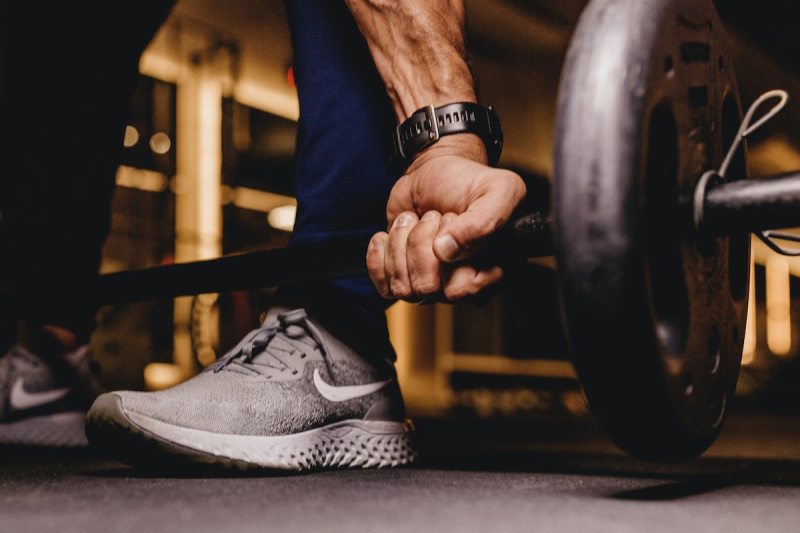
Chances are, your life is pretty busy, and you don’t have numerous hours per day to dedicate to exercising. We get it and understand that you need to take advantage of the best workouts for men to maximize the results you can get in a shorter period of time. It’s important for your workouts to be both efficient and effective, and the best way to do that is to structure your workouts to involve all major muscle groups and compound movements.
As the name implies, they target all the major muscle groups, ensuring that you’re building strength over your whole body. This helps prevent muscle imbalances, which can cause issues with posture and lead to injuries. Additionally, efficient total-body workouts incorporate compound exercises that use many muscle groups simultaneously, which is fantastic for metabolic conditioning, burning calories, and developing functional strength for all the physical demands you face in your life outside the gym.
This is due to the compound exercises being multi-joint, dynamic moves that train your muscles to work synergistically, enabling your brain to be better able to actively recruit all your muscles to work together for different tasks. And, much like the power of teamwork, muscles that work together and have been trained and strengthened together equate to much greater efficiency and enhanced function for your whole body.
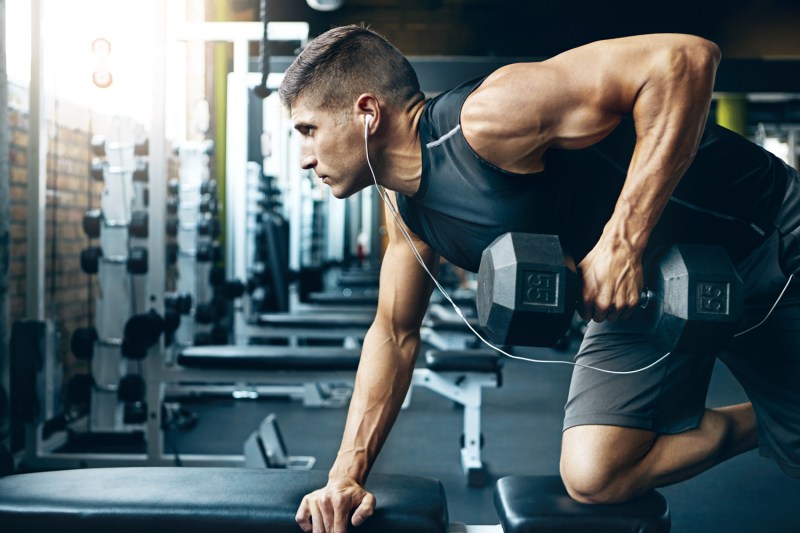
The best workouts for men
With these ideas in mind, we’ve put together a lineup of some of the most effective exercises to give you a killer total-body workout. To capitalize on the metabolic conditioning benefits of the routine, move through each exercise in a circuit-training fashion with as little rest as possible. This will keep your heart rate elevated and will maximize your calorie burn both during and after the workout.
Performing two to three sets of this routine will give your body the stimulus it needs to build muscle and burn fat while not making you feel like the gym is your second office.
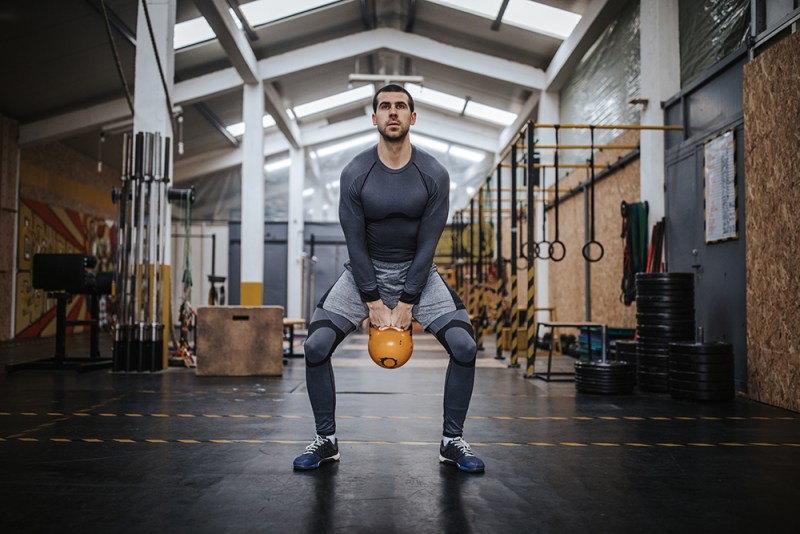
Kettlebell swings
Kettlebell swings are an excellent metabolic conditioning exercise, and they build strength and power in your shoulders, core, back, hip flexors, hamstrings, and glutes. Though it may look like an upper-body exercise, most of the power for the swing should come from your hips and glutes when you pop them forward. Move quickly and powerfully, and use a moderately heavy kettlebell.
Method:
- Stand with your feet slightly wider than shoulder-width apart, with your arms hanging down in front of your body, gripping the handle of the kettlebell with both hands.
- Bend your knees slightly, engaging your core and glutes.
- Press through your heels and explode through your hips to drive the kettlebell upward until it’s roughly chest height and your arms are fully extended out in front of your body.
- Control the kettlebell as it descends back down, allowing it to swing past the starting position and backward slightly behind your legs.
- At the end of the arc of the swing, snap your hips forward again to drive the kettlebell back up to chest height.
- Complete 12-15 reps.
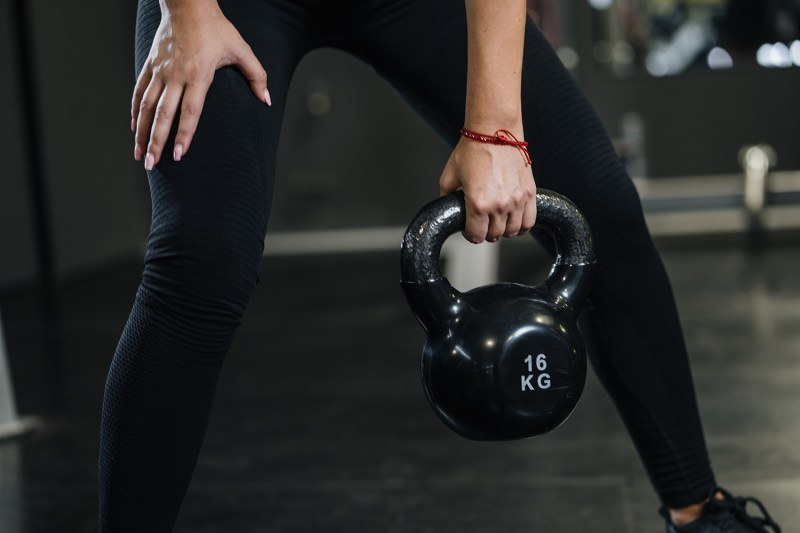
Sumo squat figure 8’s
Like standard squats, sumo squats target the quads and glutes, but the foot positioning also activates your hamstrings and adductors. In this compound exercise, you’ll weave a heavy kettlebell or dumbbell around your legs to challenge your obliques and abs as well.
Method:
- Stand with your feet about six inches wider than shoulder-width apart, with your toes pointing about 45 degrees outward. Your hips should also be externally rotated.
- Grip the handle of a heavy kettlebell with both hands down in front of your body.
- Inhale, sitting your hips backward as if reaching your butt back to sit in a chair, ensuring your core is engaged, your chest is up, and your back is straight.
- When you’re fully lowered so that your knees are bent to 90 degrees, pause and hold.
- In this lowered position, weave the kettlebell in and around each leg, passing it between your two hands, drawing a figure 8.
- After one full figure 8, exhale, pressing through your heels to return to the starting position.
- Repeat 8-10 reps.
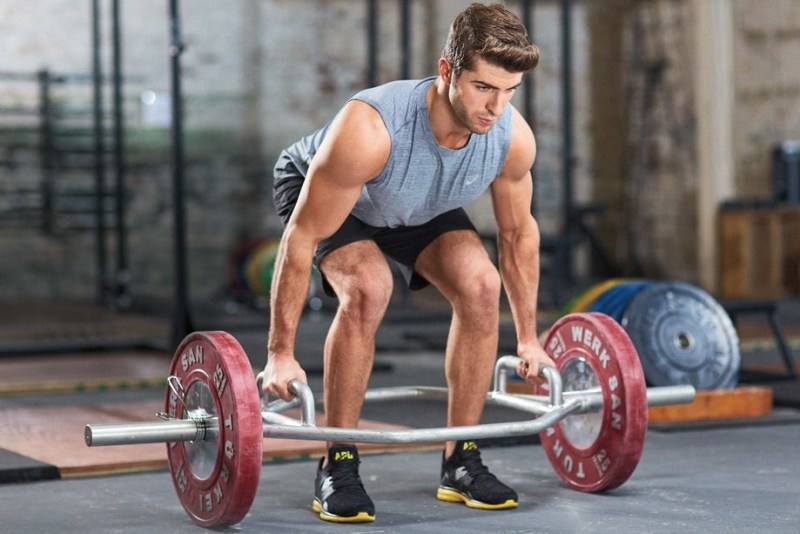
Deadlifts
The deadlift is another foundational exercise move and can be considered the king of posterior chain (glutes, hamstrings, spinal extensors, and calves) exercises. It’s an important counterpart to many of the go-to leg exercises like squats and lunges because it really focuses on the often-ignored antagonist muscles in the back of the legs. Loading the bar with as much weight as you can handle with proper form for six to eight reps is the best way to reap maximal gains from this move. You can also use a hex bar instead of a standard barbell for a more ergonomic modification.
Method:
- Stand with good posture and your feet shoulder-width apart, arms at your sides, and a loaded barbell in front of your ankles.
- Bend your knees to sit your hips back as far as possible until you’re low enough to reach and grab the bar while keeping your back straight and chest up.
- Engage your core to lift the bar while you raise your body up to the tall standing position. Your back should stay straight, and the bar should track vertically along your shins.
- Sit your hips back again to slowly lower the bar back to the floor. Keep your chin up and gaze forward during the move.
- Perform 6-8 reps per set.
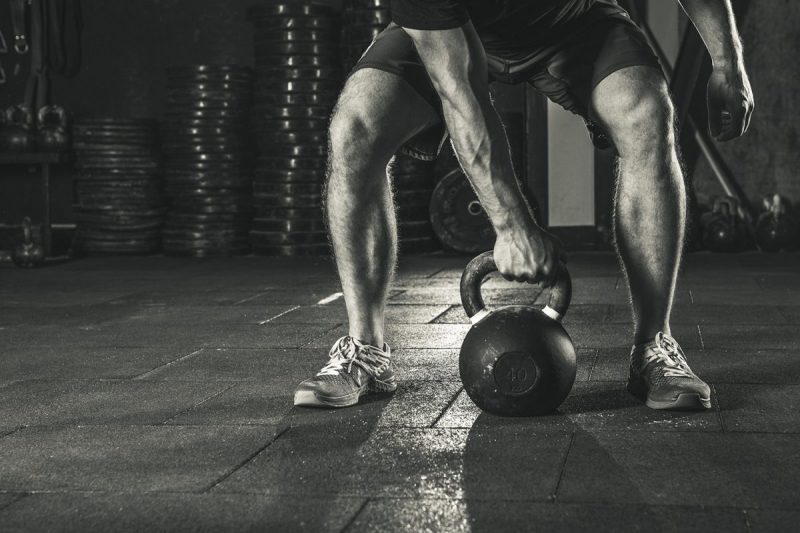
Single-arm farmer’s carry
The single-arm farmer’s carry is a total-body exercise, offering the potential for serious strengthening gains. It not only strengthens your legs and shoulders but is a fantastic functional core exercise because it is unilateral and anti-rotational — which means it’s performed on one side of the body and requires your core to stabilize and resist the tendency to twist or bend. In this way, the single-arm farmer’s carry closely mimics a lot of the real-life demands on your core. For maximal effectiveness, use the heaviest weight you can handle with the correct form.
Method:
- Stand upright with good posture holding a heavy dumbbell, kettlebell, or weighted implement in one hand. Your arms should be down at your sides.
- Keeping your core tight, your chest up, and your shoulders even, walk forward for 15 paces or 30 meters or so.
- Turn around and walk back.
- Switch arms and repeat.
- Complete three laps per side.
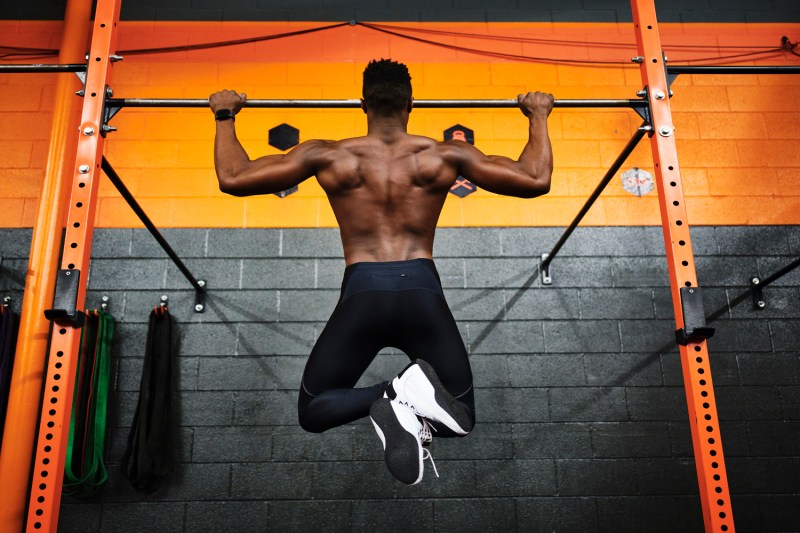
Pull-Ups
A lot of guys make the mistake of focusing too much on pressing exercises or those that work the “front” muscles—push-ups, bench press, curls, etc.—because these are the muscles we can readily see in the mirror. However, it’s equally important to strengthen your pulling muscles—the ones in your back—like your lats, rhomboids, and triceps.
Pull-ups probably take the cake for the most effective back-strengthening bodyweight exercises, and they work your chest, shoulders, and core to boot. If you’re not yet strong enough to do an unassisted pull-up, use an assisted pull-up machine to offset some of your body weight or loop a thick resistance band from the bar to under your knees to modify the move. After you master them, try wearing a weighted vest to up the difficulty.
Method:
- Grab the pull-up bar with a shoulder-width grip to properly engage your lats.
- Hang from the bar, raising your feet off the ground by bending your knees.
- Pull yourself up by engaging your core, contracting your lats, and pulling your elbows down toward the floor.
- Raise your body until the bar is at chin or chest height.
- Lower your body back down in a controlled fashion and repeat.
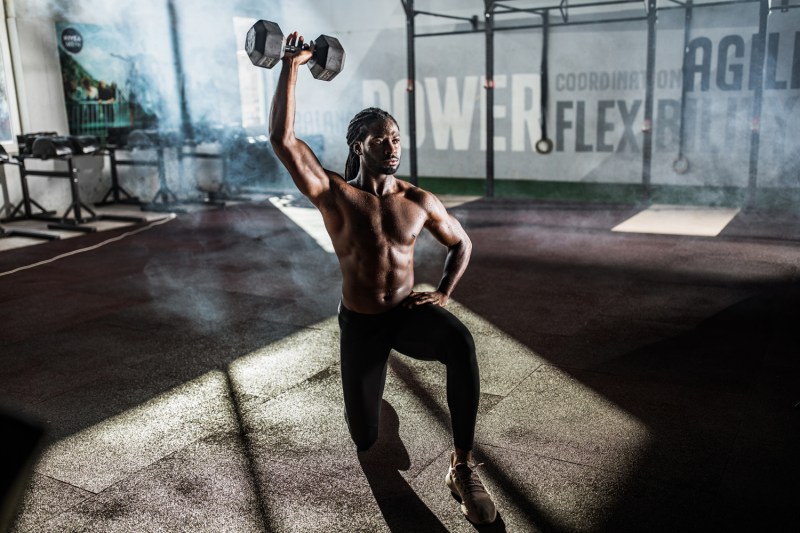
Step-ups with overhead presses
Step-ups are a multi-joint, compound exercise that works all the major muscles of the lower body while simultaneously providing a cardiovascular challenge. As such, step-ups are a powerful metabolic conditioning exercise. This variation adds an overhead press to the basic maneuver, giving you a total-body workout. Use a weight that is heavy enough to be challenging but manageable for eight to ten reps.
Method:
- Stand facing a bench, plyometric box, or step that is roughly knee height or slightly shorter. Relax your left arm at your side, and hold the dumbbell in your right hand at shoulder height.
- Engage your core and glutes while you step up onto the box with your right foot.
- Press the dumbbell straight up over your head as you step up.
- Bring your left leg up onto the box as well so that you are standing on top of the box.
- Step back down with your right foot first, then left, and return the weight to your shoulder.
- Continue leading with the right foot for 8-10 reps, and then switch sides.
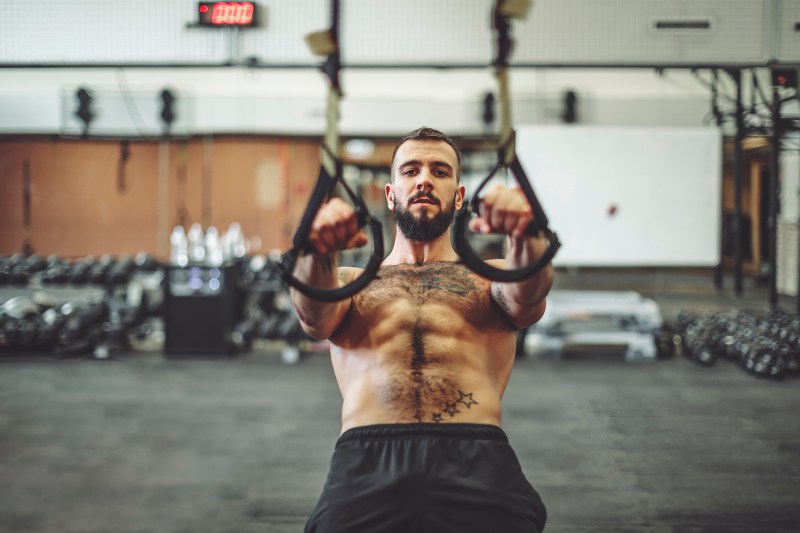
Suspended rows
Rows are a staple exercise for your back, upper body, and core. While you can certainly stick to classic bent-over dumbbell rows, bodyweight rows increase the demand on your abs and biceps. Ideally, use TRX or other suspension straps, but if those aren’t available, you can use the bar in a squat rack positioned at roughly chest height. The lower the bar, the more difficult the exercise. Regardless of the equipment you use, keep your core engaged and your shoulders back.
Method:
- Grab suspension strap handles in each hand with your arms shoulder-width apart.
- Tighten your whole body, so you are one stiff board.
- Lean back and walk your feet forward until your body is at a 10-45 degree angle relative to the ground. The further forward your feet go and the more parallel you are to the floor, the harder the exercise will be.
- You should have your heels on the floor and your toes and face pointing toward the ceiling.
- Bend your arms to raise your body up to the handles (envision yourself doing a push-up in reverse).
- Lower your body back down by straightening your arms.
- Complete 12 reps.
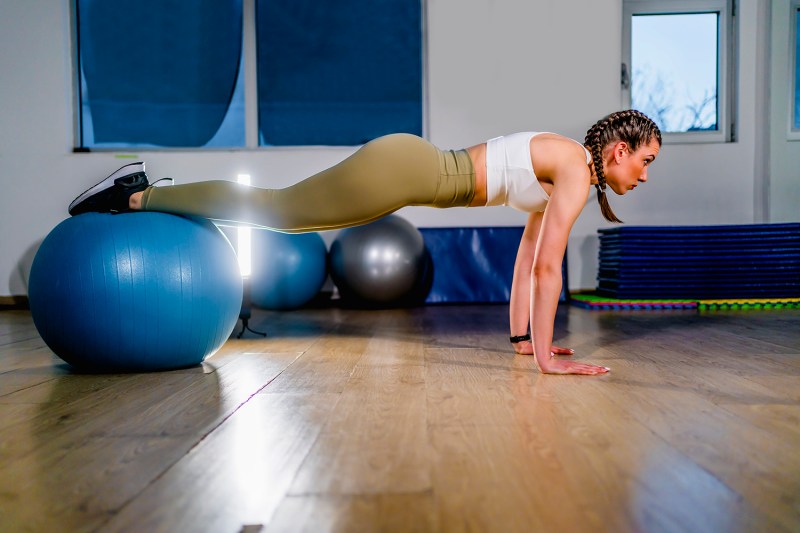
Stability ball push-ups
There aren’t many total-body workouts that skirt push-ups of some kind. After all, push-ups are a simple yet potent sculptor of your entire upper body and core. If you’re a beginner or in a less advanced stage of your fitness journey, feel free to substitute standard push-ups instead of this advanced variation.
By placing your feet up on a stability ball, you’ll not only have to engage your abs to stabilize and balance your body to prevent yourself from falling off the ball, but you’ll also drastically increase the challenge for your upper body because your feet are elevated above your hands, forcing your body into the decline push-up position where you have significantly more gravity to contend with. To make the exercise easier, keep your ankles and lower shins on the ball as well, and if you’re a push-up beast, walk your hands all the way forward so that just your toes are pressing into the ball and the rest of your body is suspended in front of the stability ball.
Method:
- Get in a push-up position with arms slightly wider than shoulder-width apart.
- One leg at a time, lift each foot and place its laces down on a large stability ball behind you. You should now be in the standard push-up position with your feet on a stability ball.
- Keep your glutes and abs engaged.
- Perform 15-25 push-ups using good form, and bring your chest as low as you can go without touching the floor.
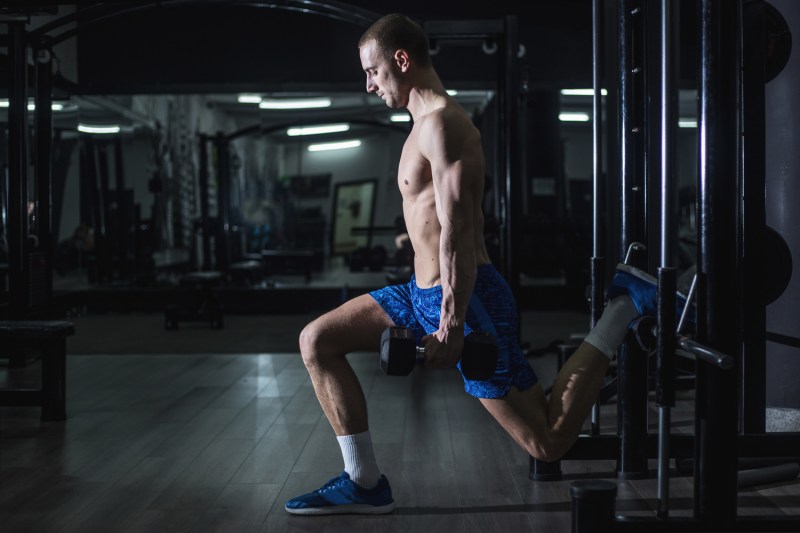
Rear-elevated split squats
Split squats, which are also called lunges, are great for strengthening your lower body, core, and spinal extensor muscles. While you can perform them with both feet on the ground, this variation elevates your rear foot to increase the activation of your hamstrings, glutes, and quads. Elevating the rear leg also requires more core activation, balance, and coordination, so it’s an advanced move that will give you a big bang for your buck.
Method:
- Stand about three feet in front of a weight bench, facing away from it with your legs shoulder-width apart and a dumbbell in each hand down at your sides.
- Reach one leg back to lie on the bench so that the laces part of your foot are contacting the bench.
- Place your front foot far enough forward such that when you drop down into a lunge, your front knee does not extend beyond the toes.
- Keeping your core engaged and maintaining good posture, bend your front knee to drop into a split squat/lunge.
- When the thigh of your front leg is parallel to the ground, press through your heel to return up to the standing position.
- Complete 8-10 reps with one leg on the bench and then switch legs.
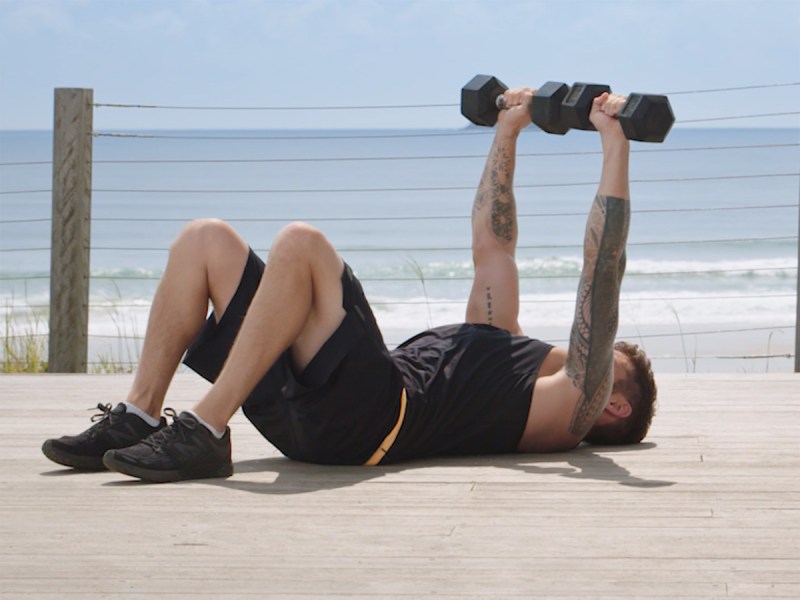
Chest press
The chest press is one of the key foundational upper body exercises. It is a modification of the bench press, but the chest press swaps out the barbell for dumbbells, requiring you to use more core stability and single-arm control. You can perform the chest press on a standard weight bench or increase the difficulty by using a stability ball instead. This will require much more core activation. However, it’s important to ensure the ball you use has a high enough weight capacity to accommodate your body weight and then dumbbells.
Method:
- Lie on your back on a weight bench or the floor with your knees bent.
- Grip the dumbbells so that your palms are facing your feet, and bring each hand into a chest press position such that your fist is hovering roughly over the armpit on that side.
- Exhale as you press the dumbbell straight up into the air above your body.
- Inhale as you slowly lower them back down.
- Complete 8-10 reps.
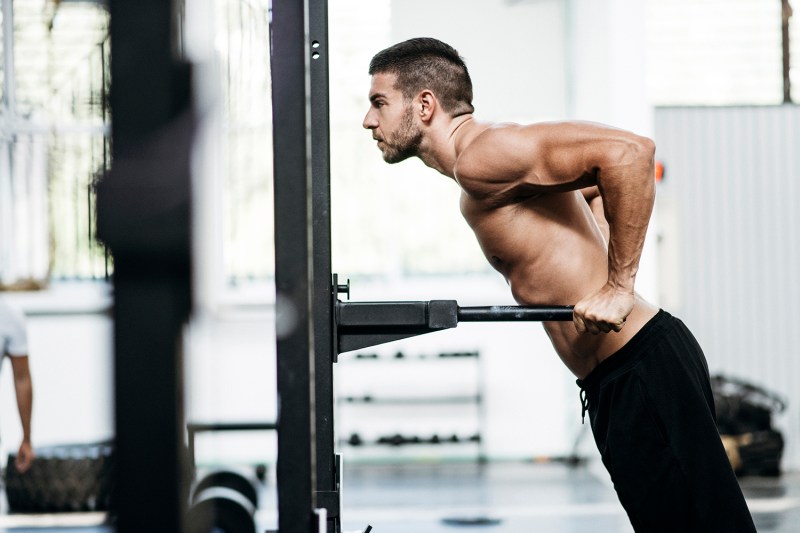
Dips
Dips are another great compound bodyweight exercise to add to your arsenal. They are a back, triceps, shoulders, core, and chest workout. Maintaining proper form is key to preventing shoulder irritation. If you aren’t yet strong enough to do dips with parallel dip bars, you can do bodyweight dips off a weight bench with your hands behind you on the bench.
Method:
- Lift your body up onto the dip bars so that your arms are straight, and lean your body forward about 45 degrees.
- Lower your body by bending your elbows until your triceps are roughly parallel to the floor.
- Push through your hands to raise your body back up to the starting position.
- Complete 12-15 reps. Add a weighted vest if you can do 15 easily.

How often should you work out to build muscle?
There’s no quick-and-dirty answer to this question, but here are some general guidelines to follow:
- Target each muscle group at least once per week; ideally two to three times for optimal growth.
- Allow at least 48 hours of rest between workouts targeting the same muscle group.
- Focus on progressive overload. This means to gradually increase weight, sets, reps, or training volume over time to keep challenging your muscles and prompting growth.
- It is important to have rest days for active recovery and to do activities like yoga or light cardio.
Remember: Consistency is key. Sticking to a regular training program with proper form and technique will yield better results than sporadic, intense workouts.



